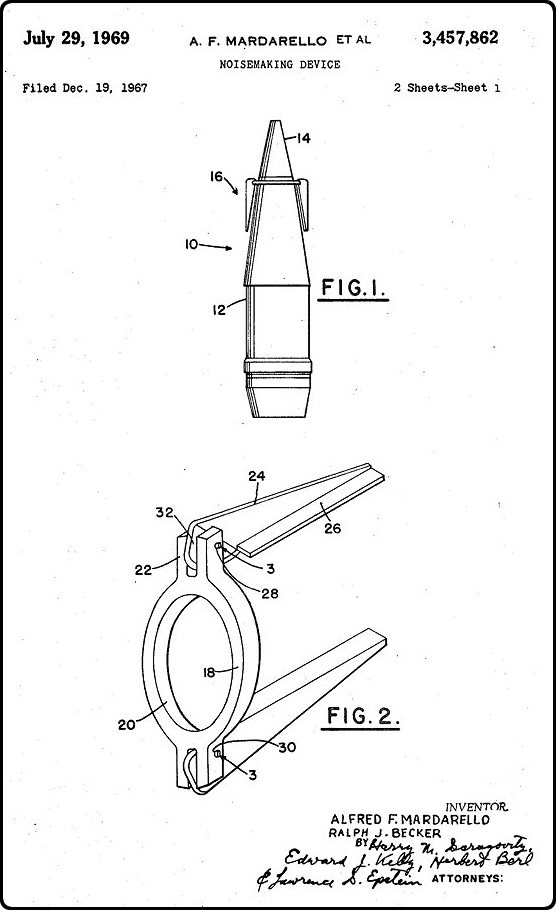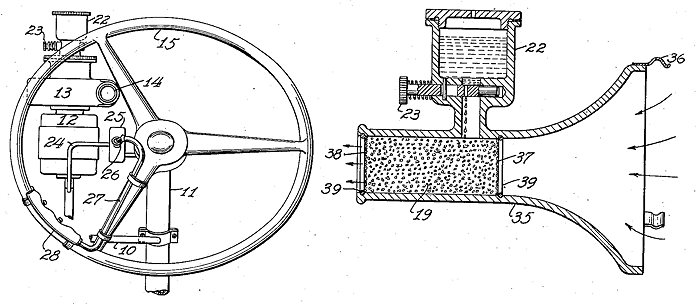Patents
Weird alien sounds designed to terrify and panic
In 1969, Alfred Mardarello et al. were granted a patent for a "noisemaking device" which could be attached to a missile. When the missile was fired and flying through the air, their gadget would create "weird, alien sounds" intended to terrify the enemy. From their patent:The psychological effects of weird or unexpected noises, which accompany an artillery projectile or missile, have been explored in many ways, prior to this invention, with minimum results. The Germans, in World War II, attached a noise producing device to aerial bombs, somewhat similar in construction to the organ pipe. A high pitched noise was created. This could be used only on large bombs and was too massive for use on artillery projectiles...
The insufficiencies of the prior art are overcome by the noisemaking adapter of the instant invention. The adapter ring is so designed that they attach to an existant missile without requiring modification of said missile. Centrifugal force, as a result of the spinning motion of the missile after being fired, causes the noisemaking arms or fins to extend and to produce weird, alien sounds of such magnitude as to be heard over a substantial area. The psychological effect, to create panic to those in the vicinity, is thus effected.
I have no idea if this patent was ever used in combat. But I don't really understand the point of making something that's already terrifying (a missile) even more terrifying by having it produce weird, alien sounds. Isn't the terror of the missile itself enough?
I guess it was part of the psychological warfare effort during Vietnam. See also Ghost Tape Number Ten.

Posted By: Alex - Sun Jul 11, 2021 -
Comments (5)
Category: Patents, 1960s, Weapons, Cacophony, Dissonance, White Noise and Other Sonic Assaults
Uncle Sam Eagle
Happy Fourth of July!Mary E. Harris of San Francisco was so proud of her patriotic idea of grafting the face of Uncle Sam onto the body of a bald eagle, that she decided to patent it, receiving US Design Patent No. 51415 in 1917.

Posted By: Alex - Sun Jul 04, 2021 -
Comments (2)
Category: Art, Holidays, Patriotism, Patents
Horse Spike
In 1899, Patent No. 636,430 was granted to Franz and Konrad Hieke of Philadelphia for what they described as "cavalry equipment". It was essentially a large spike attached to the front of a horse. From their patent:
A better view:

Argos Reflector - Feb 8, 1900
I wonder if one of these was ever actually used in combat?
Posted By: Alex - Tue Jun 22, 2021 -
Comments (3)
Category: Animals, Inventions, Patents, Weapons, Nineteenth Century
Staying awake at the wheel
Over the years, inventors have dreamed up a variety of ways to keep drivers awake while driving.In 1936, Carl Brown got a patent on a chin-operated alarm device. If a driver started to nod off, and his head fell forward, this would depress a trigger, setting off an electric bell that would wake him up. (Patent No. 2,066,092)

In 1940, Raymond Young had the idea that whenever a driver was feeling drowsy he could press a button on the steering wheel and this would squirt an aromatic spray in his face, waking him up. (Patent No. 2,199,060)

And just last month, Hyundai was granted a patent for a system that shoots ultrasonic beams at a driver's eyes when it senses he's falling asleep. (Patent No. 11007932)

Posted By: Alex - Mon Jun 14, 2021 -
Comments (3)
Category: Inventions, Patents, Sleep and Dreams, Cars
Urine-Collecting Shoe
Problem: you're out in public and really need to go to the bathroom, but there are no toilets around.Solution: the urine-collecting shoe, patented by Ran Rahimzada in 2008.
As described in his patent:
According to the present invention, a new shoe includes a container to store a person's urine. The person may use a standard catheter, which is connected to the container in the shoe.
This is an unobtrusive device, there is no bag attached to one's foot, etc. The device may be used discreetly, without attracting undue attention.

Posted By: Alex - Sun May 30, 2021 -
Comments (1)
Category: Inventions, Patents, Body Fluids, Shoes
Field Umbrella
Patent No. 2,320,848 was granted to Hollie Lee Byars of Parrish, Alabama for an umbrella designed to protect people stooped over. She imagined it would be useful for field workers. Although anyone who spent a lot of time hunched over could benefit.There have been times when I've been weeding my yard that I could have used something like this.

Posted By: Alex - Fri May 21, 2021 -
Comments (3)
Category: Inventions, Patents, 1940s, Weather
Animating Plants
Many people talk to their plants, but the plants don't talk back. However, a new invention allows the plants not to talk back, but at least to communicate, by moving. For instance, you could ask a plant if it needed to be watered, and the plant would shake up and down to indicate 'yes'.From the patent granted to Richard J. Maddocks et al:
The invention can provide an opportunity for retailers, distributors or gift givers to customize the behavior and content of the plant's behavior.
The present invention can provide a technique for the plant through its behavior to communicate its physiological needs for irrigation, light, fertilizer etc.


Posted By: Alex - Sun May 09, 2021 -
Comments (2)
Category: Communications, Inventions, Patents, Nature, Technology
Combined hat and comb
In 1920, Alva Dawson of Florida was granted a patent for a "combined head covering and hair comb". In his patent he explained:I'm pretty sure it wasn't possible to use this hat-comb without rendering yourself very conspicuous.


Popular Science - Oct 1920
Posted By: Alex - Sun May 02, 2021 -
Comments (0)
Category: Patents, Headgear, 1920s, Hair and Hairstyling
A Horn for Airplanes
Invented by Charles Adler, Jr. of Baltimore and granted a patent in 1947.I imagine the last thing you'd want to hear as your flight is cruising at 30,000 feet is the pilot suddenly honking the horn.
Though, of course, the horn was intended for small planes, not passenger jets.
Adler himself used it to nag his wife by flying low over his house and honking the horn so that she'd know to start preparing his dinner.


Massillon Evening Independent - Aug 1, 1946
Posted By: Alex - Sun Apr 25, 2021 -
Comments (3)
Category: Inventions, Patents, Air Travel and Airlines, 1940s
Cigarette lighter that gives the finger
In 1942, George Horther was granted a patent for what he called an "electric resistance lighter". From what I can gather, lifting the finger activated the lighter. He had received a separate design patent in 1940 for the invention's appearance.
Curiously, in neither patent did Horther ever refer to the significance of the gesture his invention is making, even though that's pretty much the entire point of it.
I imagine he must have intended to sell this as a gag gift, but I can't find any evidence that he ever did manage to market it.

Posted By: Alex - Sun Apr 18, 2021 -
Comments (0)
Category: Inventions, Patents, Smoking and Tobacco, 1940s

| Who We Are |
|---|
| Alex Boese Alex is the creator and curator of the Museum of Hoaxes. He's also the author of various weird, non-fiction, science-themed books such as Elephants on Acid and Psychedelic Apes. Paul Di Filippo Paul has been paid to put weird ideas into fictional form for over thirty years, in his career as a noted science fiction writer. He has recently begun blogging on many curious topics with three fellow writers at The Inferior 4+1. Contact Us |




